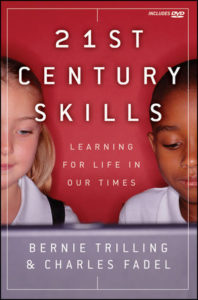Between 2008 and 2011, I wrote several brief reviews of books which appeared on the Education Review web site. Since then, the editors ceased publication of that type of review and removed the previously published brief reviews from the site. I am making the original drafts of my reviews available here.
Brief Review of Fadel, C., & Trilling, B. (2009). 21st Century Skills: Learning for Life in Our Times. San Francisco: Jossey-Bass.
By Dr. Gary L. Ackerman, March 2010
 Educators who have been paying attention to the pedagogical theory and practice that has emerged in the first decade of the 21st century will find little that is new in this book. Trilling and Fadel have been involved with the Partnership for 21st Century Skills for several years, and the contents of this book have been available on that organization’s web site for several years. Still, the book promises to serve an important role as individual teachers, local schools, professional associations, and state leaders face the problem of transforming 20th century schools into 21st century schools.
Educators who have been paying attention to the pedagogical theory and practice that has emerged in the first decade of the 21st century will find little that is new in this book. Trilling and Fadel have been involved with the Partnership for 21st Century Skills for several years, and the contents of this book have been available on that organization’s web site for several years. Still, the book promises to serve an important role as individual teachers, local schools, professional associations, and state leaders face the problem of transforming 20th century schools into 21st century schools.
In the 177 pages, readers will find answers to two questions: What is 21st century learning? and What are 21st century skills? Trilling and Fadel take two chapters to answer the first question and three chapters to answer the second question. The remainder of the book (four chapters) focuses on the classroom practices, school organizations, and societal visions and commitments that will be necessary to transform schools into institutions where students use technology to develop the problem-solving experience, global awareness, and interpersonal skills that are the basis for the education model that is proposed.
At times, the book reads like a laundry list of ideas and practices that could be easily dismissed as disconnected fads that will not transform schooling in a systematic manner. It becomes clear, however, that the laundry list is really a comprehensive description of 21st century schools. In isolation, any one reform proposed in the book is likely to be a disconnected fad; together the ideas form a comprehensive vision for schools and a framework for transforming the many dimensions of schooling that need attention for the vision to be reality.
The intended audience for the book does not appear to be an academic one; references are sparse, academic readers are likely to be distracted by the lack of sources, and careful readers are likely to find ideas that are drawn from other authors but are not referenced. For many stakeholders; including community members, school board members, and politicians; the lack of references will not interfere with the value of the book. For other stakeholders, including educators and education leaders, whose schedules ostensibly interfere with academic reading, the lack of references is a concern, but the book remains useful. In academic settings, the lack of references is a greater concern, but- presumably- finding the research to support the claims made in the book will be useful and instructive. One can reasonably conclude, then, that this book can be read by a wide range of individuals who are interested in the future of K-12 schooling.
Adding to the value of the book for use in diverse settings is the organization of the text which lends itself to a variety of group reading strategies. Also, the companion DVD includes video clips from schools in which the ideas proposed have already been implemented. Further, the appendices include several web resources that support and illustrate the ideas proposed by the authors.
In summary, this book provides a comprehensive vision of 21st century schools and it can be adapted for use in a variety of settings. In clear and simple terms, readers are introduced to the schools we need to prepare young people (and educators) for the coming decades.